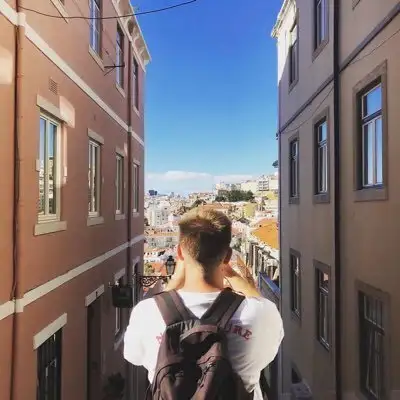Ascending a journey up a beautiful mountain in this bedtime story: The Climb. Scale and challenge yourself to reach the top.
Show Notes
Suitable for all ages.
Narrated by Lucy Roslyn
Written by Chris Winson Longley
Music by Michael Hodgson
Produced by Magdoos Media Limited
© 2022 Magdoos Media Limited - All Right Reserved
Creators & Guests


What is Kids Bedtime Stories?
Relax and unwind with classic bedtime stories for kids. One of the best free bedtime story podcasts, perfect for those long trips and journeys with your kids
The Climb
Snuggle down and cosy up for tonight your adventure takes you on the dizzying journey of The Climb.
You wake to find yourself high above the ground and overlooking a magnificent landscape. Far beneath you, the still surface of the lake reflects the majestic mountain you are standing on. Its outline is clearly visible against the background of a perfect, azure sky. The sun is shining brightly. Occasionally gulls, which look like small white clouds skim across the surface of the water.
You are standing on a small, wooden platform no bigger than a paving slab. It juts precariously from the wall of rock but feels secure beneath your feet. You are wearing climbing shoes. They look like ordinary trainers, but the soles are extremely thin, allowing you to feel the rock as though you are wearing no shoes at all.
Made from rubber, they have immense grip. Your hands are bare, save only for the chalk dust you apply
from a small pouch that hangs from your waist. Although you are surrounded by the cold air found at high
altitudes, climbing is hard work and as your hands begin to sweat, they will slip. You will need the chalk to
dry them. With a final check to make sure your climbing harness is tight, and the safety rope is secure, you turn your attention to your task: the climb.
The rock is the colour and texture of sand, formed from layer upon layer of sediment compressed over
millions of years. As you climb from the oldest rock at the base to the youngest at the top, you are travelling through time. The horizontal tiers look like a giant layer cake. In places the surface has eroded, forming cups and small ledges, perfect for hand or footholds.
Casting your eye over the surface, you note the exact location of each potential hand and foothold as you
plot a route. This first part of the climb is relatively simple, and you confidently reach for the first handhold.
Keeping your body close to the rock you pull yourself up. Your feet easily find the cups and ledges you
identified, allowing your hands the freedom to move higher. And so, alternating between hands and feet
you scale the rock like a giant lizard.
Arriving at the platform, you immediately fasten your safety rope to the carabiner (kara-beana) dangling
from a metal bolt driven securely into the rock. The carabiner is brightly coloured in neon green and easy to
spot. Made of a light alloy it looks like a large keyring, but it is very strong and will easily take your weight
should it need to. Once secure, you stand and examine the next part of your ascent. You are full of energy
and eager to continue. You can see that the next section will be more difficult.
Climbing steadily, you reach the first of the awkward handholds. You are positioned with both hands
clutching a small indentation directly in front of your chest. Both of your feet are together on a small ledge,
and you are standing bolt upright. This position is difficult to hold and it pushes you away from the rock face.
You are careful not to lean too far back so as not to lose your grip. Carefully, you remove each hand in turn
and dip them in the chalk bag that hangs from your waist. Then, carefully extending your left leg, you locate a foothold a few feet away. Transferring your weight onto your left foot, you force your body to pivot around it like the hands of a clock. Then, releasing your left hand, you reach out as far as you can as
your leg becomes fully extended, your fingers find the new hold. You grip it tightly and with all your weight
on your left foot, pause, but only for a moment. With your right foot dangling free, your right hand joins
your left and you automatically reach for the next hold. This one is much closer and deeper, and you can
grip it with your whole hand, making you feel very secure. After a few moments rest, you chalk each hand
again, locate a new hold for your right foot, and continue on your way.
By the afternoon you reach the halfway point. You are pleased with your progress and have developed a
close relationship with the mountain. At times you have found yourself only centimetres from the tiny
alpine flowers that find a home in smallest of cracks. Earlier, from one of the platforms you were amazed to spot a loan ibex. These wild mountain goats scale the almost vertical surface of the rock with ease, and you are in awe of how well they are adapted to their environment.
You are now so high that the lake has shrunk in size, and you can no longer see the gulls or their reflections.
Occasionally, you come across an abandoned nest and wondered what might happen if it were occupied by a fearsome parent protecting its young.
Turning your thoughts back to the climb, you are aware that you are approaching the most difficult section, or pitch. Each one has been progressively more difficult than the one before and you are reaching the limits of what you are capable of.
The rock is eroding significantly, and the handholds are covered in dust and debris. Before you can put your trust in them, you have to make sure they are clean and that your grip is secure. This means you cannot move in a fluid, seamless motion and are forced instead to pause repeatedly. Hanging by one hand, if only for a few seconds at a time, uses up vital reserves of energy. For the last few metres of the pitch there are no footholds at all. Using just your hands you shuffle sideways, like a crab, and your muscles start to burn.
Your legs dangle beneath you in a vast empty space of sky, heavy as lead, and you feel your muscles being drained of all their strength. Just as you think you will have to release your grip and rely on the safety rope to break your fall, you reach the end of the ledge. With an enormous effort you manage to haul yourself onto the wooden platform, where, once secured to the carabiner, you are exhausted and your heart is thumping in your chest.
As the pulsing in your chest subsides and your breathing becomes steadier, you notice a change in the air.
Looking up, you see that you are closer to the summit than you thought. There is a fresh breeze blowing
across the top of the mountain, carrying with it the scent of pine needles. Two more pitches and you will be at the top.
After a while you stand and stretch your aching muscles. The sun is high overhead, and you are surrounded by golden light. You breathe deeply and fill your lungs with the fresh mountain air. You feel invigorated and ready to face the final challenge.
To your surprise the next pitch is easy. There are plenty of places to use as holds and you make rapid
progress towards the final platform. Grasping the wooden edge, you are reassured by its rough surface. It
provides plenty of grip and you pull yourself up into a standing position. With your safety rope secured to
the carabiner, you walk to the very edge of the platform. From here the sky is a vast ocean of air. You raise
your arms wide, close your eyes and feel like you are flying.
Full of confidence and renewed energy, you turn to plot a course on the final pitch.
You are pleased to find the climb as easy as the previous pitch. The handholds are frequent and there are
numerous ledges for your feet. It takes only a few minutes for you to make your way around the outcrop
and into the cleft, but here you are forced to stop. Inexplicably, the rock changes into a sheer, smooth
surface with no possibility of traversing it. Not even a dextrous and sure-footed ibex would dare to cross.
Examining the flat rock as it reaches the end of the cleft and extends into the next outcrop, you are
distracted by a flash of green and realise there is a carabiner on the rock face directly opposite where you
are. Here, the rock returns to its eroded condition and you see that this is the way you must go. There is no alternative but to cross the gap. It is only a metre wide but demands a risky manoeuvre. The difficulty lies in having to rotate your body. It would be relatively easy to stretch out your leg and step across the gap as there is a ledge level with the one you are standing on, but then you would be left stranded across the cleft with no momentum to carry you over. It would be better if the opposite ledge were lower, then gravity would carry you across. You realise that you will have to step across and let go at the same time. By throwing your arm out towards the opposite wall, you should generate enough momentum to take you
across. But you will have to grab the carabiner immediately, before your own weight pulls you away from
the vertical surface. Should that happen, you will fall at least twice your height before the safety rope takes up the slack. You dip your hands in chalk and ready yourself for the manoeuvre.
Keeping your eye firmly fixed on the carabiner, you step out across the gap. Feeling the subtle shift in your
centre of gravity, you throw your arm outwards and reach. As your foot touches the rock, your fingers close around the metal, and you begin to flatten your body against the rock. The last of your momentum carries your other arm and leg over and you come to a halt. You are relieved to have made it across but are quick to secure your safety rope before finally allowing yourself to feel safe. You are filled with a sense of
achievement and a smile spreads across your face. You have shown courage and determination, and have
pushed yourself past your own limits.
You have to repeat the manoeuvre twice more as you follow the zigzag of the mountain but eventually you
find the vertical surface begins to level out. You begin to scramble on all fours rather than climb, and the
rock turns into grass. The air is filled with the scent of pine needles, and you observe fragile butterflies
flitting between the sparse alpine flowers.
Finally, you stop and lay down on the cooling ground. The sun is approaching the horizon and the shadows
of the pine trees are long and dark. There is a path that leads through the forest that will take you back
down, but you are content to lie here for now, absorbing the last of the sunlight. Your whole body aches,
but it feels good. It comes from having pushed yourself further than you thought possible and achieving
something extraordinary. As you stare into the endless blue of a vast sky, your muscles relax, your breathing slows, and you feel yourself getting tired.
Now the day is coming to an end you begin to appreciate how far you have come. You've learned about the mountain, you've climbed higher than the birds soar and you've seen the world from a different perspective. It's a beautiful place, and you are grateful to have made it safely.
You're tired now. The sun is slowly slipping fast away, the forest is getting darker and the mountain is
getting colder. You know you need to find shelter before it's too late, but you don't want to leave the
mountain top. You enter the edge of the forest and lean against an ancient pine. Its trunk is surprisingly
warm and you hope you wake to see the sunrise across this beautiful landscape. As you think of the next
day, your eyes grow heavy and close as you drift away, awaiting your next adventure.
